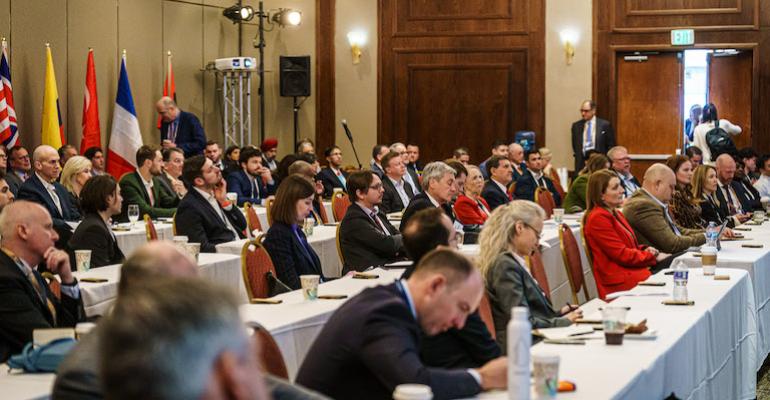The CMA conference panel on Trading Routes and Agreements, moderated by Marsoft CEO Arlie Sterling, had a focus on economics, but it was heavily shaded by geopolitics.
Freight economics, while full of uncertainties, are straightforward. Kevin Hazel, who looks after tanker and drybulk markets at Marsoft, opined on peak demand in the oil markets- suggesting that demand slowdowns in the Western economies, as alternatives gain traction, would be offset by continued growth in India and China. Overall, slow growth, on the order of 2% per annum, would be a reasonable expectation.
On the dry side, the growth path would be similar, with iron ore demand possibly seeing a plateau of sorts. “Coal has room to grow,” according to Hazel. Over the longer term, however, “It is hard to see oil demand growing beyond the 2030’s” he said, and he reminded shipowners that “the orderbook needs to be kept in line.” But the big wild card, going out into the future, will be shifting trade patterns.
Panel member James Frew, providing business advisory within Lloyds Register, stressed that the changes seen since the late February, 2022 onset of the war in Ukraine, are likely to be long lasting- with vessels replacing movements of gas that had previously been moving in pipelines. He suggested that pipelines feeding Russian gas into Europe, were handling 30% of pre-war capacity.
Over time, he expressed a very positive view of LNG trades, with potential growth “the high single digits annually” over the next decade. In response to a question about the large orderbook in the sector, he suggested that it would be absorbed by future demand.
Talking about the market farther out in time, he alluded to possible future movements of new cargoes, notably hydrogen and ammonia, would play a more important role; possibly, we would see ships transporting LNG and ammonia. He suggested that, potentially, 250 million tons per year of ammonia might be moving at sea by 2050.
The complicated patchwork of geopolitics was the focus of panel member Henrik Ehlers Krach, Senior Director at consultancy Risk Intelligence, who said he was “less optimistic about the security situation” than the commodity prognosticators. The trend towards regionalisation, with symptoms such as near-shoring is already underway; he said that this could lead to less intervention at times of conflicts.
“The real risks exist on land,” he emphasized. Longer term, into the next decade, he prophesied that “ESG will affect trade patterns,” with different commodities moving. “New security concerns will arise with new cargo flows.”
Lawyer Sean Pribyl, a Partner at Holland & Knight with considerable experience in Washington, D.C., pointed to the interactions of trade agreements and finance legislation as bringing about demand for new cargoes particularly in the movement of minerals to be used in batteries. Importantly, the United States has inked deals with Japan and the European Union that will facilitate these trades, reminding the audience of the links between trades and national security.
On the question of the recent “pause” in approvals of LNG export terminals, Pribyl said that the pause, if it lingers, “could severely hinder the ability of the United States to be a global leader.”
Copyright © 2024. All rights reserved. Seatrade, a trading name of Informa Markets (UK) Limited.
Add Seatrade Maritime News to your Google News feed.  |

